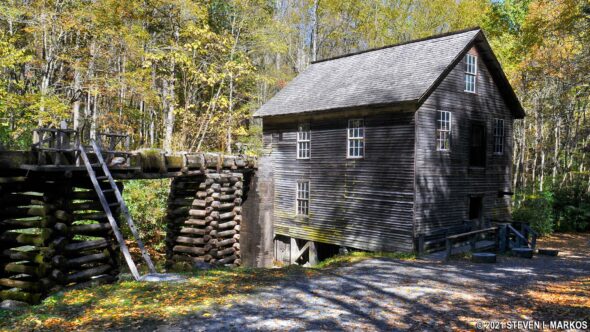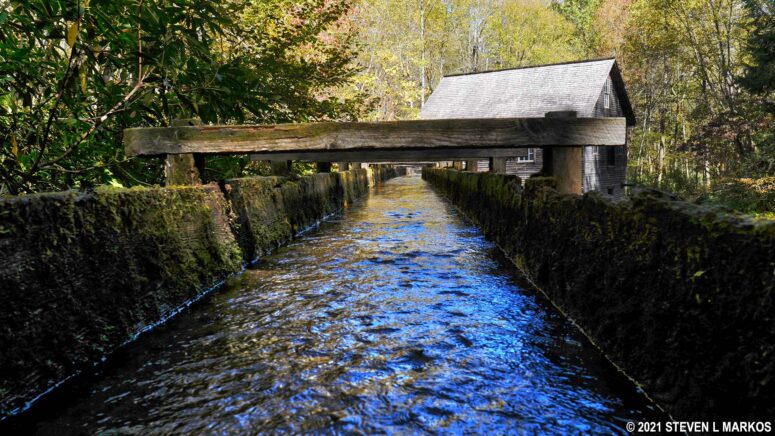See the Smokemont Region web page for an interactive location map.
Mingus Mill is a steel turbine-powered grist mill located off of Newfound Gap Road a few miles from the Cherokee, North Carolina, entrance to Great Smoky Mountains National Park. From the parking area it is a short walk to the mill. This is a popular tourist stop, so don’t be surprised to find a full parking lot on a busy day. However, visits to the mill are short, so parking space turnover is frequent.
The mill was built in 1886 by Thomas Early and takes its name from the water source that provides it with power, Mingus Creek. It was powered by a turbine instead of a waterwheel. Turbines are a much more efficient way to power a mill, for just about all of the water that flows through the mill’s water shaft, called a penstock, is used to turn the turbine. With a water wheel, much of the water spills out over the sides, plus the wheel itself dips into the water as it turns, creating a great amount of drag.
Water is used to turn the turbine, which is like a large propeller with many blades. This power is derived from an elevated flume that carries water from Mingus Creek and empties into the vertical penstock next to the mill.
The force of the falling water causes the main turbine to spin, like blowing air into a pinwheel. The faster the falling water, the faster the turbine spins and the more power created, just as the harder you blow into a pinwheel the faster it spins. To imagine what a turbine looks like, just picture a waterwheel laid flat on the ground with a steel shaft sticking up from its center. The photo below is an industrial-size turbine used to power a textile mill in Lowell, Massachusetts. The turbine used at Mingus Mill is simply be a much smaller version of this one. The turbine is located as far below the water source as possible, giving the water ample time to build up speed before hitting the turbine blades. At Mingus Mill the turbine is below the mill building.
The turbine has a vertical, steel shaft similar to an automobile drive shaft. The shaft enters the mill from the bottom floor and extends all the way to the third floor. Horizontal, secondary shafts on each floor are connected by metal gears to this main vertical shaft. The secondary shafts usually run across the room near the ceiling. Leather belts are connected to these shafts at one end and to a machine on the other. As the main turbine spins, the secondary shaft spins, which in turn spins the belt that causes the machine—in this case a grindstone—to operate. In the photo below, notice the vertical steel shaft with a gear on it (middle of photo) and the shaft and gear located next to it near the floor (in this case, the secondary shafts run along the floor, not the ceiling). Also notice the pulley wheels at the top, left corner of the photo. Leather belts would be strung around these and attached to a similar wheel on the actual machine. Also, the base of a turbine lies on the floor at the bottom left corner. If this makes no sense at all, I’m not surprised, but it is the best I can do to describe the process. Lucky for visitors to the mill, you can actually walk underneath it and see the main turbine being spun by the water. Mingus Mill actually works!
Mingus Mill was operated by various owners until around 1930 when the land and mill were purchased by the state government for inclusion in Great Smoky Mountains National Park. It was restored to working order in 1937 with the help of one of the mill’s original builders, an assistant to Thomas Early, Aden Carver. The mill was then leased to John Jones, who ran it until the early 1940s. At that time it sat idle until the 1960s. Today it is again up and running, and visitors can tour the facility and see corn being ground into meal and flour. The mill is usually open daily from 9 AM to 5 PM from April through the end of October, and then on Friday, Saturday, and Sunday during November. It is closed the rest of the year.
A visit to Mingus Mill is a self-guided experience and takes about a half hour. Volunteers are on hand to answer questions and demonstrate how corn is ground into meal. However, without somebody explaining how the system works its pretty hard to comprehend it. A formal tour would be very educational. While information signs are scattered around the mill, most of these discuss the mill’s history, not the technology.
In the long run, most people just want to see corn kernels put in one end and come out as flour on the other, which is done on the first floor. In fact, you can buy authentic stone ground flour at Mingus Mill, though it is actually ground at a similar mill in nearby Pigeon Forge, Tennessee. Because tourists are allowed into the mill, the Food and Drug Administration won’t issue a permit to produce a salable product due to “unsanitary conditions.”
The second floor of the building is also open. Here you will find a wheat cleaner and other machines used in the grinding process. Information panels explain the process, though again, not as well as an actual human being could. The third floor is closed to the public.
Outside you can follow the water flume back to the source, Mingus Creek. It is only a couple minute’s walk along flat terrain from the mill. The trip is worth the time because you can see how water is diverted from the creek and into the flume.
With a few exceptions, use of any photograph on the National Park Planner website requires a paid Royalty Free Editorial Use License or Commercial Use License. See the Photo Usage page for details.
Last updated on February 15, 2021












